Holding a guitar pick, or plectrum, might seem like a no-brainer, especially if you’ve been playing for years. However, the subtle nuances in how you grip your pick can significantly impact your guitar playing, affecting everything from tone and speed to control and comfort. Many guitarists, even seasoned players, discover breakthroughs in their technique simply by refining their plectrum grip.
You might have stumbled upon online discussions where players, particularly in genres like blues and bluegrass, talk about how changing their pick grip unlocked new levels in their playing. One technique mentioned involves positioning the index finger parallel under the thumb, rather than perpendicularly. While experimenting with this “fist” method can indeed produce a stronger, louder tone, it can also initially feel harder to control the pick’s depth and achieve a smooth rhythm.
This exploration into pick grip isn’t trivial; it’s a fundamental aspect of guitar technique. Let’s dive into the common methods of holding a guitar pick and explore how to find the grip that best suits your playing style and musical goals.
Exploring Different Plectrum Grips
Let’s review three primary ways to hold a guitar pick. You may already be familiar with these, but understanding the nuances of each can be incredibly beneficial.
1. The “O” Method (or Standard Grip):
This is arguably the most common and often recommended method, striking a balance between control and tonal versatility. It involves forming an elongated “O” shape with your thumb and index finger. The pick is held between the side of your thumb and the side of your curled index finger.
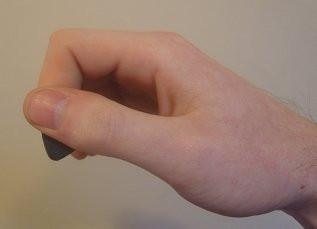 Standard Guitar Pick Grip Method 1
Standard Guitar Pick Grip Method 1
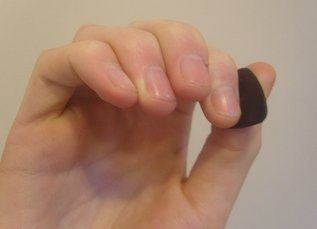 Standard Guitar Pick Grip Method 2
Standard Guitar Pick Grip Method 2
This grip offers a good level of control for both rhythm and lead playing, allowing for precision and a balanced tone. It’s adaptable to various pick gauges and musical styles, making it a solid foundation for most guitarists.
2. The “Pinch” Method (or Flat Grip):
The “pinch” method prioritizes pick flexibility and is achieved by using the flat of your index finger rather than the side. The pick is pinched between the thumb and the flat surface of the index finger.
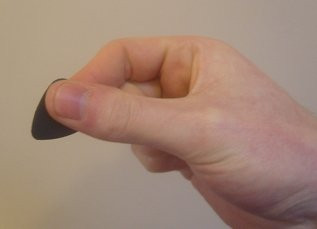 Pinch Guitar Pick Grip Method 1
Pinch Guitar Pick Grip Method 1
 Pinch Guitar Pick Grip Method 2
Pinch Guitar Pick Grip Method 2
This grip is often favored by guitarists who use lighter gauge picks and frequently engage in strumming. The increased flexibility allows for a softer attack and smoother strumming patterns, ideal for acoustic styles and lighter genres.
3. The “Fist” Method (or Parallel Grip):
The “fist” method, also known as the parallel grip, is characterized by curling the index finger directly parallel under the thumb, creating a more closed fist-like hold.
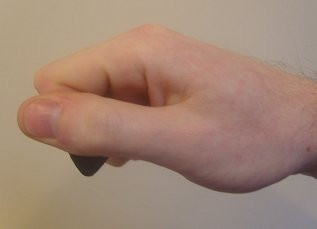 Fist Guitar Pick Grip Method 1
Fist Guitar Pick Grip Method 1
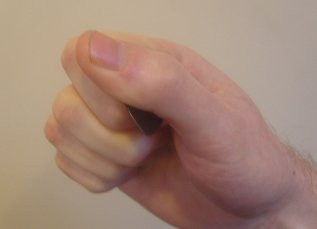 Fist Guitar Pick Grip Method 2
Fist Guitar Pick Grip Method 2
This grip is often associated with players who use heavier gauge picks, particularly in genres like bluegrass and some styles of rock. It can produce a powerful and direct tone, offering more attack and volume. However, as you mentioned, it can initially feel less controlled, especially for intricate rhythm playing.
Finding Your Ideal Grip: Experimentation is Key
It’s important to remember that these three methods are not rigid rules but rather starting points. Variations exist within each, such as how much the index finger is curled or how tightly you grip the pick. The optimal pick grip is ultimately a matter of personal preference, and often depends on factors like:
- Pick Gauge: Heavier picks often pair well with firmer grips like the “fist” method, while lighter picks may benefit from the flexibility of the “pinch” method.
- Musical Style: Aggressive styles might favor grips that produce a strong attack, while softer styles may benefit from grips that offer more finesse and flexibility.
- Playing Technique: Are you primarily a rhythm player, a lead player, or a mix of both? Your playing style will influence the control and tone you need from your pick grip.
Experiment with Pick Gauges and Grips:
The best approach is to experiment. Try different pick gauges in combination with each of these holding methods. Spend time playing scales, chords, and songs you are familiar with, paying close attention to how each combination feels and sounds.
Personal Experience and Adaptation:
Many guitarists, including myself, have settled on a “compromise” grip, often based on the “O” method, as it offers a versatile foundation that can be adapted for various playing situations. For example, when playing funk with rapid 16th note strumming, a lighter pick and a slightly looser grip might be preferred for greater flexibility and rhythm. However, for lead playing or genres requiring a stronger attack, a slightly firmer grip and potentially a heavier pick could be more suitable.
The Value of Consistency:
While experimentation is valuable, especially when you are starting out or feeling stuck, it’s also crucial to consider the progress you’ve already made with your current technique. If you’ve developed significant muscle memory and playing ability with a particular grip, switching to a completely different method might require a step backward in the short term.
“If it ain’t broke, don’t fix it” is a relevant adage here. Unless you are experiencing limitations or discomfort with your current pick grip, or are actively seeking a specific tonal change, drastic changes might not be necessary.
Embrace Curiosity, But Stay Focused:
It’s natural to be curious and explore different techniques, especially when inspired by great players. Short periods of experimentation are healthy and can lead to valuable insights. However, avoid getting caught in a cycle of constant tweaking and second-guessing your grip. Choose a method that feels reasonably comfortable and allows you to achieve the sounds you desire, then focus your energy on musical expression and further skill development.
Practical Experimentation:
To effectively explore different pick grips, visit your local guitar store and purchase a variety of pick gauges, ranging from very light (e.g., 0.38mm) to heavy (1mm+). Over the next few days, dedicate practice time to trying out the three main grip methods (and slight variations) with these different picks.
Play through songs, riffs, and exercises you already know well. This will allow you to directly compare the feel and sound of each combination. After a few days of focused experimentation, you should be able to identify the grips and pick gauges that feel most natural and effective for your playing.
If you find yourself torn between a few options, choose one and commit to it. Then, importantly, shift your focus back to your musical goals and enjoy the journey of playing guitar!
Ultimately, the “best” way to hold a guitar plectrum is the way that empowers you to play the music you love with confidence and control.

